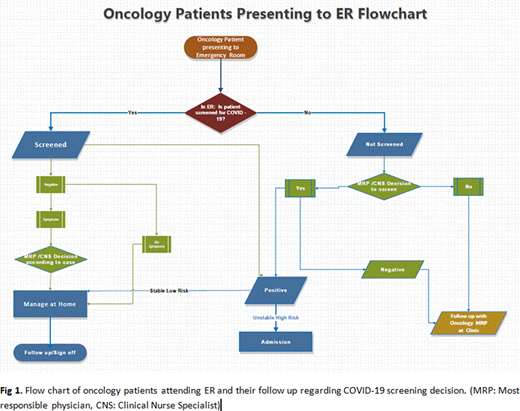Background
COVID-19 pandemic disrupted heath care system all around the world and overwhelmed the capacity of hospital to manage regular patients including cancer patients. We implemented a new program to help managing oncology patients visited our Emergency Rooms (ER) and discharged home.
Methods
Our home care program designed to cover all aspects of patients care while they are at home by checking the ER list on daily basis and identify all oncology patients on this list. We developed an algorithm, to follow up our patients and the COVID-19 test status and to act accordingly (figure 1). The team consists of oncologist, oncology nurse specialists, patient educator and data management person. The primary oncologist of each patient is notified and consulted on the plan. The team follows the result and decide further steps of management accordingly. The intervention includes regular clinical assessment by calling the patient, arranging medication delivery, sending patients brochures explaining the necessary protective measured needs to be taken by patient and care givers and respond to patient and family queries and concerns.
Results
Between May 31 and July 31, 237 oncology patients seen in ED with different clinical presentations. One hundred forty two patients did not need admission and therefore discharged home. COVID-19 test was carried out according to the presenting symptoms and ARI score (test requested if score is 4 or more). Only 30 patients (21%) needed COVID-19 testing prior to discharge from ED and 6 patients tested positive. However, on our follow of those patients at home further 16 patients (11%) needed to be tested due to new developments of their symptoms and 3 patients tested positive. The main reasons for nor requesting COVID-19 for some patients either 1) recent testing in outpatient clinics or other health centers outside our institution Ministry of Health, 2) they are known to have covid-19 and still in active infection, 3) based on patient`s MRP decision not to swab patient for COVID -19. During our daily monitoring of patients at their homes, 12 patients (8%) were called back due to worsening of their symptoms and needed further assessment and management after discussion with their MRP. As per our infection control department guidelines, repeating COVID-19 testing for asymptomatic patients was not necessary and patient can be discharged from our records. This new model of care in our institution was presented to the COVID-19 pandemic command center and the program got the approval and recommended to be implemented in other departments as per patients need.
Conclusion
Oncology patients are vulnerable especially at this time of COVID-19 pandemic and our program is designed to reduce the risk of exposure and infection by looking after those patient while they are at home in addition to maintain the continuity of their cancer management.
No relevant conflicts of interest to declare.
Author notes
Asterisk with author names denotes non-ASH members.


This feature is available to Subscribers Only
Sign In or Create an Account Close Modal